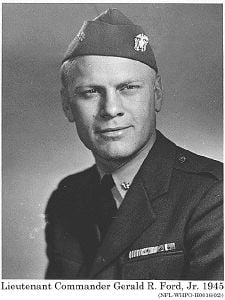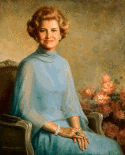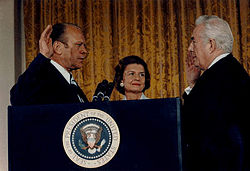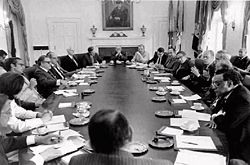Gerald Ford
| Term¬†of¬†office | August 9, 1974¬†‚ÄstJanuary 20, 1977 |
| Preceded by | Richard Nixon |
| Succeeded by | Jimmy Carter |
| Date of birth | July 14, 1913 |
| Place of birth | Omaha, Nebraska |
| Date of death | December 26, 2006 |
| Place of death | Rancho Mirage, California |
| Spouse | Betty Warren Ford |
| Political party | Republican |
Gerald Rudolph Ford, Jr. ( July 14, 1913 ‚Äď December 26, 2006) was the 38th president of the United States. He also served as the 40th vice president. He was the first person appointed to the vice presidency under the terms of the Twenty Fifth Amendment, and upon succession to the presidency became the first (and to date, the only) president in U.S. history to fill that office without having been elected either president or vice president.
Taking office upon the resignation of the disgraced president Nixon, Ford was confronted with several challenges: mastering inflation, reviving a depressed economy and solving chronic energy shortages; but first there was the task of bringing together a divided nation riven by the Watergate scandal. To bring closure, Ford pardoned Richard Nixon as one of the first acts of his presidency. This unpopular decision took considerable courage, yet in the light of history many recognize that it was the right thing to do.
Ford also brought closure to the painful Vietnam War era by withdrawing U.S. troops. The fall of South Vietnam and the subsequent genocide in Cambodia occurred during Ford's watch.
Early life
Ford was born in Omaha, Nebraska on July 14, 1913, to Leslie Lynch King and Dorothy Ayer Gardner, and was originally named Leslie Lynch King, Jr. His parents separated shortly after he was born and they divorced five months after his birth. Two years later his mother married Gerald Ford, after whom he was renamed despite never being formally adopted. Raised in Grand Rapids, Michigan, Ford was not aware of his biological father until he was 17.
Ford joined the Boy Scouts and attained that program's highest rank, Eagle Scout. He always regarded this as one of his proudest accomplishments even after attaining the White House. In subsequent years, Ford received the Distinguished Eagle Scout Award and Silver Buffalo from the Boy Scouts of America. He attended Grand Rapids South High School and was a star athlete, rising to become captain of his high school football team. In 1930 he was selected to the All-City team of the Grand Rapids City League. He also attracted the attention of college recruiters.
Attending the University of Michigan as an undergraduate, Ford became the center for the school's football team and helped the Wolverines to undefeated seasons in 1932 and 1933. His number 48 jersey has since been retired by the school. At Michigan, Ford was a member of the Delta Kappa Epsilon fraternity and washed dishes at his fraternity house to earn money to pay for college expenses. While at Michigan, Ford turned down contract offers from the Detroit Lions and Green Bay Packers of the National Football League following his graduation in 1935 in order to attend law school. As part of the 1935 Collegiate All-Star football team, Ford played against the Chicago Bears in an exhibition game at Soldier Field.
While attending Yale Law School he joined a group of students led by R. Douglas Stuart, Jr. and signed a petition to enforce the 1939 Neutrality Act. The petition was circulated nationally and was the inspiration for America First, a group determined to keep America out of World War II. However, Ford's position on American involvement in the war would soon change.
Ford graduated from law school in 1941 and was admitted to the Michigan bar shortly thereafter. Before he could commence a law practice, though, overseas developments caused a change in plans. Like others, Ford responded to the attack on Pearl Harbor and joined the military.
World War II
In April 1942, Ford joined the United States Naval Reserve, receiving a commission as an ensign. After an orientation program at Annapolis, he became a physical fitness instructor at a pre-flight school in Chapel Hill, North Carolina. In the spring of 1943, he began service on the light aircraft carrier U.S.S. Monterey as athletic director and gunnery division officer. Eventually promoted to assistant navigator on the Monterey, he and the ship took part in most of the major operations in the South Pacific, including Truk, Saipan, and in the Philippines. Ford's closest call with death was during a vicious typhoon in the Philippines Sea in December 1944. He spent the remainder of the war ashore and was discharged as a lieutenant commander in February 1946.
Marriage and family
On October 15, 1948, Ford married Betty Bloomer Warren at Grace Episcopal Church, in Grand Rapids. This was Mrs. Ford's second marriage. The Fords had four children: Michael Ford, a minister; John "Jack" Ford, a journalist/public relations consultant; Steven Ford, an actor and rodeo rider; and Susan (Ford) Vance Bales, a photographer.
Mrs. Ford was noted for her outspokenness on topics including pre-marital sex and the Equal Rights Amendment. This was a sharp contrast from most First Ladies, particularly her immediate predecessor, the reticent Pat Nixon. Mrs. Ford publicly battled breast cancer during her husband's presidency. After leaving office, her battles with alcoholism and addiction were discussed prominently in the media, as was the family's support in opening the Betty Ford Center in Rancho Mirage, California.
House of Representatives
Following his return from the war, Ford became active in local Republican politics. Grand Rapids supporters urged him to take on Bartel J. Jonkman, the incumbent Republican congressman. Ford had changed his worldview as a result of his military service; "I came back a converted internationalist," Ford stated, "and of course our congressman at that time was an avowed, dedicated isolationist. And I thought he ought to be replaced. Nobody thought I could win. I ended up winning two to one.‚ÄĚ
During his first campaign, Ford visited farmers and promised he would work on their farms and milk the cows if elected‚ÄĒa promise he fulfilled.
Ford was a member of the House of Representatives for 24 years, holding the Grand Rapids congressional district seat from 1949 to 1973. Appointed to the House Appropriations Committee two years after being elected, he was a prominent member of the Defense Appropriations Subcommittee. Ford described his philosophy as "a moderate in domestic affairs, an internationalist in foreign affairs, and a conservative in fiscal policy. In 1963 Republican members of the House elected him Minority Leader. During his tenure, President Lyndon B. Johnson appointed Ford to the Warren Commission, a special task force set up to investigate the assassination of President John F. Kennedy. The commission's conclusion that Lee Harvey Oswald had acted alone in killing the Kennedy remains controversial.
During the eight years (1965‚Äď1973) he served as house Minority Leader, Ford won many friends in the House of Representatives because of his fair leadership and inoffensive personality.
Vice Presidency, 1973‚Äď1974
After Vice President Spiro Agnew resigned during Richard Nixon's presidency October 10, 1973, Nixon nominated Ford to take Agnew's position on October 12; this was the first time that the vice presidential vacancy provision of the Twenty-fifth Amendment had been applied. The United States Senate voted 92 to 3 to confirm Ford on November 27, and on December 6 the House confirmed him 387 to 35. Ford continued to reside in the same home he had as a congressman until he became the first vice president to move into the new vice president's official residence at Number One Observatory Circle.
Ford's tenure as vice president was little noted by the media. Instead, reporters were preoccupied by the continuing revelations about criminal acts during the 1972 presidential elections and allegations of cover-ups within the White House. Ford said little about the Watergate scandal.
The Watergate investigation continued following Ford's appointment until Chief of Staff Alexander Haig contacted Ford on August 1, 1974, and told him that "smoking gun" evidence had been found. The evidence left little doubt that President Nixon had been a part of the Watergate cover-up.
Presidency, 1974‚Äď1977
Accession
When Nixon resigned in the wake of the Watergate scandal on August 9, 1974, Ford assumed the presidency. Immediately after taking the oath of office in the East Room of the White House, he spoke to the assembled audience in a speech broadcast live to the nation. Ford noted the peculiarity of his position: "I am acutely aware that you have not elected me as your president by your ballots, and so I ask you to confirm me as your president with your prayers."
Nixon pardon
On September 8, 1974, Ford gave Nixon a full and unconditional pardon for any crimes he may have committed while president. In a televised broadcast to the nation, Ford explained that he felt the pardon was in the best interests of the country and that the Nixon family's situation "is an American tragedy in which we all have played a part. It could go on and on and on, or someone must write the end to it. I have concluded that only I can do that, and if I can, I must." At the same time as he announced the Nixon pardon, Ford introduced a conditional amnesty program for Vietnam War draft dodgers who had fled to countries such as Canada. Unconditional amnesty, however, did not come about until the Jimmy Carter presidency.
Ford's first press secretary and close friend Jerald terHorst resigned his post in protest after the announcement of Nixon's full pardon.
Administration and Cabinet
Upon assuming office, Ford inherited the cabinet Nixon selected during his tenure in office. Over the course of Ford's relatively brief administration, only Secretary of State Henry Kissinger and Secretary of the Treasury William Simon remained. Ford appointed William Coleman as Secretary of Transportation, the second African American to serve in a presidential cabinet (after Robert Clifton Weaver) and the first appointed in a Republican administration.
Ford selected George H. W. Bush to be both ambassador to the People's Republic of China in 1974 and Director of the Central Intelligence Agency in 1975. In 1975 Ford also selected former congressman and Ambassador Donald Rumsfeld as Secretary of Defense. Rumsfeld had previously served as Ford's transition chairman and later chief of staff. Additionally, Ford chose a young Wyoming politician, Richard Cheney, to be his new chief of staff and later campaign manager for Ford's 1976 presidential campaign. Ford's dramatic reorganization of his cabinet in the fall of 1975 has been referred to by political commentators as The "Halloween Massacre."
| The Ford Cabinet | ||
|---|---|---|
| OFFICE | NAME | TERM |
| President | Gerald Ford | 1974‚Äď1977 |
| Vice President | Nelson Rockefeller | 1974‚Äď1977 |
| Secretary of State | Henry A. Kissinger | 1974‚Äď1977 |
| Counsellor to the President | Robert T. Hartmann | 1974‚Äď1977 |
| Secretary of the Treasury | William E. Simon | 1974‚Äď1977 |
| Secretary of Defense | James R. Schlesinger | 1974‚Äď1975 |
| Donald Rumsfeld | 1975‚Äď1977 | |
| Attorney General | William Saxbe | 1974‚Äď1975 |
| Edward Levi | 1975‚Äď1977 | |
| Secretary of the Interior | Rogers Morton | 1974‚Äď1975 |
| Stanley K. Hathaway | 1975 | |
| Thomas Savig Kleppe | 1975‚Äď1977 | |
| Secretary of Agriculture | Earl L. Butz | 1974‚Äď1976 |
| John A. Knebel | 1976‚Äď1977 | |
| Secretary of Commerce | Frederick B. Dent | 1974‚Äď1975 |
| Rogers C. B. Morton | 1975 | |
| Elliot L. Richardson | 1975‚Äď1977 | |
| Secretary of Labor | Peter J. Brennan | 1974‚Äď1975 |
| John T. Dunlop | 1975‚Äď1976 | |
| William Usery, Jr. | 1976‚Äď1977 | |
| Secretary of Health, Education, and Welfare | Caspar Weinberger | 1974‚Äď1975 |
| Forrest D. Mathews | 1975‚Äď1977 | |
| Secretary of Housing and Urban Development | James T. Lynn | 1974‚Äď1975 |
| Carla A. Hills | 1975‚Äď1977 | |
| Secretary of Transportation | Claude Brinegar | 1974‚Äď1975 |
| William T. Coleman, Jr. | 1975‚Äď1977 | |
Mid-term elections
The 1974 Congressional midterm elections took place less than three months after Ford assumed office. Occurring in the wake of the Watergate scandal, the Democratic Party was able to turn voter dissatisfaction into large gains in the House election, taking 49 seats from the Republican Party and increasing their majority to 291 of the 435 seats. Even Ford's reliably Republican seat was taken by Democrat Richard VanderVeen. In the Senate election, the Democratic majority became 60 in the 100-seat body. In both houses, the numbers were above or close to the two-thirds mark required to override a presidential veto, and the 94th Congress overrode the highest percentage of vetoes since Franklin Pierce was president in the 1850s.
Domestic policy
The economy was a great concern during the Ford administration. In response to rising inflation, Ford went before the American public in October 1974 and asked them to "whip inflation now." As part of this program, he urged people to wear "WIN" buttons.In hindsight, this was viewed as simply a public relations gimmick without offering any effective means of solving the underlying problems. At the time, inflation was around seven percent.
The economic focus began to change as the country sank into a mild recession, and in March 1975, Ford and Congress signed into law income tax rebates as part of the Tax Reduction Act of 1975 to boost the economy. When New York City faced bankruptcy in 1975, Mayor Abraham Beame was unsuccessful in obtaining Ford's support for a federal bailout. The incident prompted the notorious New York Daily News headline: "Ford to City: Drop Dead."
Ford was confronted with a potential swine flu pandemic. Sometime in the early 1970s, an influenza strain H1N1 shifted from a form of flu that affected pigs and crossed over to humans. On February 5, 1976, an army recruit at Fort Dix mysteriously died and four fellow soldiers were hospitalized; health officials announced that swine flu was the cause. Soon after, public health officials in the Ford administration urged that every person in the United States be vaccinated.
Foreign policy
The Ford Administration saw the final withdrawal of American personnel from Vietnam in Operation Frequent Wind, and the subsequent fall of Saigon. On April 29, and the morning of April 30, 1975, the American embassy in Saigon was evacuated amidst a chaotic scene. Some 1,373 U.S. citizens and 5,595 Vietnamese and third country nationals were evacuated by military and Air America helicopters to United States Navy ships off-shore.
From the prior administration, in addition to longstanding Cold War issues, Ford inherited the on-going d√©tente with both the Soviet Union and the People's Republic of China‚ÄĒand the policy of building relationships with the two communist countries, which had been mutually antagonistic toward each other for many years.
Ford also faced a foreign policy crisis with the Mayaguez Incident. In May 1975, shortly after the Khmer Rouge took power in Cambodia, Cambodians seized the American merchant ship Mayaguez in international waters. Ford dispatched Marines to rescue the crew, but the Marines landed on the wrong island and met unexpectedly stiff resistance just as, unknown to the U.S., the Mayaguez sailors were being released. In the operation, fifty U.S. servicemen were wounded and 41 killed while approximately 60 Khmer Rouge soldiers were killed.
Assassination attempts
Ford faced two assassination attempts during the course of his presidency; both over a three-week period. While in Sacramento, California on September 5, 1975, Lynette "Squeaky" Fromme, a follower of cult leader and convicted murderer Charles Manson, pointed a .45-caliber handgun at Ford and pulled the trigger. Though the gun was loaded with five bullets, it was an automatic pistol requiring the first round to be "chambered." The slide mechanism had not been pulled to place a bullet in the firing chamber, making it impossible for the gun to fire. Fromme was taken into custody immediately; she was later convicted of attempted assassination of the president and was sentenced to life in prison.
In 1979 Fromme was transferred out of the women's prison in Dublin, California for attacking a fellow inmate with the claw end of a hammer. Fromme claimed self-defense. On December 23, 1987, she escaped from the Alderson Federal Prison Camp in Alderson, West Virginia, attempting to meet up with Manson, whom she had heard had testicular cancer. She was captured two days later and and incarcerated at the Federal Medical Center, Carswell in Fort Worth, Texas. She is currently serving life in prison. After serving 34 years in custody, she was released on parole on August 14, 2009.
Seventeen days later, another woman, Sara Jane Moore, also tried to kill Ford while he was visiting San Francisco, but her attempt was thwarted when bystander Oliver Sipple deflected her shot. No one was injured when Moore fired, and she was later sentenced also to life in prison. Moore, a former nursing school student, Women's Army Corps recruit, and accountant, Moore had five husbands and four children before she turned to revolutionary politics in her forties. According to some reports, she was recruited as an informant by the Federal Bureau of Investigation to gain information on the Patty Hearst kidnappers, but her cover was blown. In order to carry out a plot she planned with a radical organization and prove herself with her radical friends, she attempted to shoot Ford.
On February 6, 1979, Moore escaped from the Alderson Federal Prison Camp, a minimum security prison, in Alderson, West Virginia, but was recaptured the next day and subsequently relocated to the federal women’s prison in Pleasanton, California. On December 31, 2007, at the age of 77, she was released from prison on parole after serving 32 years of her life sentence.
Supreme Court appointment
In 1975 Ford appointed John Paul Stevens as associate justice of the Supreme Court of the United States to replace retiring Justice William O. Douglas. Stevens had been a judge of the United States Court of Appeals for the Seventh Circuit, appointed by President Nixon. During his tenure as House Republican leader, Ford had led efforts to have Douglas impeached. After being confirmed, Stevens eventually disappointed some conservatives by siding with the Court's liberal wing regarding the outcome of many key issues. Nevertheless, Ford subsequently paid tribute to John Paul Stevens: "He has served his nation well," Ford said of Stevens, "with dignity, intellect and without partisan political concerns."
1976 presidential election
Ford reluctantly agreed to run for office in 1976 but first had to counter a challenge for the Republican Party nomination. Former California Governor Ronald Reagan and the party's conservative wing faulted Ford for failing to do more in South Vietnam, for signing the Helsinki Accords and for negotiating to cede the Panama Canal. Reagan launched his campaign in the autumn of 1975 and won several primaries before withdrawing from the race at the Republican Convention in Kansas City, Missouri. The conservative insurgency convinced Ford to drop the more liberal Vice President Nelson Rockefeller in favor of Bob Dole, a U.S. Senator from Kansas.
Ford's campaign had an advantage from several activities held during 1976 celebrating the United States Bicentennial. The Washington, D.C. fireworks display was presided over by the president and televised nationally.
Democratic nominee and former Georgia governor Jimmy Carter campaigned as an outsider and reformer; he gained support from voters dismayed by the Watergate scandal. Carter led consistently in the polls, and Ford was never able to shake voter dissatisfaction following Watergate and the Nixon pardon.
Presidential debates were reintroduced for the first time since the 1960 election. While Ford was seen as the winner of the first debate, during the second debate he inexplicably blundered when he stated, "There is no Soviet domination of Eastern Europe and there never will be under a Ford Administration." Ford also said that he did not "believe that the Poles consider themselves dominated by the Soviet Union."
In the end, Carter narrowly won the election, receiving 50.1 percent of the popular vote and 297 electoral votes compared with 48.0 percent and 240 electoral votes for Ford. Despite the loss by only two percent of the vote, Ford had in the three months between the Republican National Convention and the election closed what at one point was a 34-point Carter lead. With the loss, Ford became the only unelected president in the history of the United States.
Had Ford won the election, he would have been disqualified by the Twenty Second Amendment from running in 1980, since he served more than two years of Nixon's term.
Post-presidential years
The pardon controversy eventually subsided, and Ford now is widely regarded as being mainly responsible for restoring the American public's faith and confidence in their political system. Ford's incorruptible character and personal decency helped restore dignity to the executive branch.
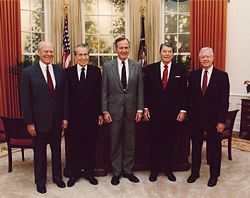
Ford remained relatively active in the years after his presidency and continued to make appearances at events of historical and ceremonial significance to the nation, such as Presidential inaugurals and memorial services. In 1981 he opened the Gerald R. Ford Museum in Grand Rapids, Michigan, and the Gerald R. Ford Library in Ann Arbor, Michigan.
In 2001 he was presented with the John F. Kennedy Profiles in Courage Award for his decision to pardon Richard Nixon to stop the agony America was experiencing over Watergate. In retirement Ford also devoted much time to his love of golf, often playing both privately and in public events with comedian Bob Hope, a longtime friend.
As Ford approached his ninetieth year he began to experience significant health problems. He suffered two minor strokes at the 2000 Republican National Convention, but made a quick recovery. President George W. Bush visited former President Ford in April 2006 at Ford's home in Rancho Mirage; the former president, walking with a cane, escorted Bush back outside to his car after visiting for about an hour.
On November 22, 2004, New York Republican Governor George Pataki named Ford and the other living former presidents as honorary members of the board rebuilding the World Trade Center.
Ford was a close friend of his successor Jimmy Carter, despite the fact that Carter defeated him in the 1976 presidential election. Carter and his wife, Rosalynn, had many visits at Mr. and Mrs. Ford's home.
President Ford passed away on December 26, 2006 at his home in Rancho Mirage, California with his family at his side.
Major Publications
- Ford, Gerald R. Humor and the Presidency. New York, NY: Arbor House, 1987. ISBN 0877959188
- Ford, Gerald R. and John R. Stiles. Portrait of the assassin (Lee Harvey Oswald). New York, NY: Simon & Schuster, 1965. ASIN B0006BMZM4
- Ford, Gerald R. Gerald R. Ford: Presidential Perspectives from the National Archives. National Archives & Record Service, 1994. ISBN 1880875047
- Ford, Gerald R. Selected Speeches, Edited by Michael V. Doyle. Arlington, VA: R. W. Beatty, 1973. ISBN 0879480297
- Ford, Gerald R. Time to Heal: The Autobiography of Gerald R. Ford. Norwalk, CT: Easton Press, 1987. ISBN 0060112972
ReferencesISBN links support NWE through referral fees
Personal memoirs and official biographies
- Cannon, James. Time and Chance: Gerald R. Ford's Appointment with History. Ann Arbor, MI: University of Michigan Press, 1993. ISBN 0472084828
- Ford, Betty. The Times of My Life. New York, NY: Harper & Row, 1979. ISBN 0060112980
Administration officials' publications
- Casserly, John J. The Ford White House: Diary of a Speechwriter. Boulder, CO: Colorado Associated University Press, 1977. ISBN 0870811061
- Coyne, John R. Fall in and Cheer. Garden City, NY: Doubleday, 1979. ISBN 0385111193
- Hartmann, Robert T. Palace Politics: An Insider's Account of the Ford Years. New York, NY: McGraw-Hill, 1980. ISBN 0070269513
- Hersey, John. Aspects of the Presidency: Truman and Ford in Office (The President: A Minute-by-Minute Account of a Week in the Life of Gerald Ford). New Haven, CT: Ticknor & Fields, 1980. ISBN 089919012X
- Kissinger, Henry A. Years of Renewal. New York, NY: Simon & Schuster, 1999. ISBN 0684855720
- Thompson, Kenneth (ed.). The Ford Presidency: Twenty-Two Intimate Perspectives of Gerald Ford. Lanham, MD: University Press of America, 1980. ISBN 0819169609
Other sources
- Brinkley, Douglas. Gerald R. Ford. New York, NY: Times Books, 2007. ISBN 0805069097
- Firestone, Bernard J. and Alexej Ugrinsky, eds. Gerald R. Ford and the Politics of Post-Watergate America. Westport, CT: Greenwood Press, 1992. ISBN 0313280096
- Greene, John Robert. The Limits of Power: The Nixon and Ford Administrations. Bloomington, IN: Indiana University Press, 1992. ISBN 0253326370
- Greene, John Robert. The Presidency of Gerald R. Ford. Lawrence, KS: University Press of Kansas, 1995. ISBN 0700606394
- Mieczkowski, Yanek. Gerald Ford and the Challenges of the 1970s. Lexington, KY: University of Kentucky Press, 2005. ISBN 0813123496
- Werth, Barry. 31 Days: The Crisis That Gave Us the Government We Have Today. New York, NY: Doubleday, 2006. ISBN 0385513801
External links
All links retrieved May 21, 2024.
- U.S. Congress biographical entry
- Brief biography of Gerald Ford
- Gerald R. Ford Foundation
- Ford Library and Museum
| Preceded by: Bartel J. Jonkman |
United States Representative for the 5th Congressional District of Michigan 1949‚Äď1973 |
Succeeded by: Richard F. Vander Veen |
| Preceded by: Charles A. Halleck |
House Minority Leader 1965‚Äď1973 |
Succeeded by: John Jacob Rhodes |
| Preceded by: Spiro Agnew |
Vice President of the United States December 6, 1973 ‚Äď August 9, 1974 |
Succeeded by: Nelson Rockefeller |
| Preceded by: Richard Nixon |
Republican Party Presidential nominee 1976 (lost) |
Succeeded by: Ronald Reagan |
| Preceded by: John G. Roberts |
United States Order of Precedence as of 2006 |
Succeeded by: Jimmy Carter |
| Preceded by: Valery Giscard d'Estaing |
Chair of the G8 1976 |
Succeeded by: James Callaghan |
Credits
New World Encyclopedia writers and editors rewrote and completed the Wikipedia article in accordance with New World Encyclopedia standards. This article abides by terms of the Creative Commons CC-by-sa 3.0 License (CC-by-sa), which may be used and disseminated with proper attribution. Credit is due under the terms of this license that can reference both the New World Encyclopedia contributors and the selfless volunteer contributors of the Wikimedia Foundation. To cite this article click here for a list of acceptable citing formats.The history of earlier contributions by wikipedians is accessible to researchers here:
The history of this article since it was imported to New World Encyclopedia:
Note: Some restrictions may apply to use of individual images which are separately licensed.
